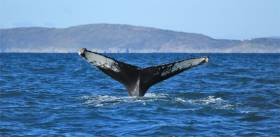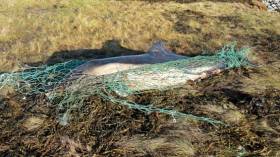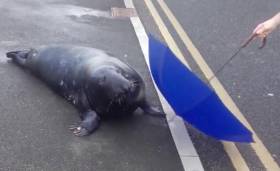Displaying items by tag: marine wildlife
'Whale & Dolphin Trail' Proposed For Cork Coast
#MarineWildlife - Cork County Council has heard a proposal for a dedicated whale and dolphin trail along the county's coastline, as the Southern Star reports.
The Old Head of Kinsale, Mizen Head, Galley Head and Baltimore have already been identified as key locations for interpretive panels along the trail, the plans for which have had input from the Irish Whale and Dolphin Group (IWDG) and Fáilte Ireland, to tie in with the latter's Wild Atlantic Way initiative.
"A lot of people might think this is trivial, but it’s a huge tourism attraction around the world and whale watching in Co Cork is the best in Europe," said Cllr Christopher O’Sullivan. "It’s about time we realised this as it could have huge economic impact for the region."
The Southern Star has more on the story HERE.

#MarineWildlife - Strandings of common dolphins for the first two months of the year are at their second highest since records began in 2002, says the Irish Whale and Dolphin Group (IWDG).
A total of 28 confirmed standings were recorded in the IWDG's strandings database in January and February of this year, just below 2013's worst figures so far when 31 were reported.
That compares to an average of fewer than six reports for the same period each year between 2002 and 2010.
The current decade has seen a significant jump in recorded figures, with 18 reports of dolphin standings in 2011 compared to just two in the same months in 2010.
Many of the dolphins found this year were recorded in the North West, a great number of them drowned according to post-mortem results, while others showed signs of being tangled in fishing gear, which suggests they were bycatch in the nets of supertrawlers that ply the seas off Donegal, Sligo and Mayo.
"While there is no conclusive proof of what vessels are involved, the evidence points to the presence of large (c.100m) foreign registered freezer trawlers fishing in Irish offshore waters."
That's according to the IWDG's strandings officer Mick O'Connell, who warns that "the number of bycaught dolphins that actually get washed ashore and recorded as stranded may be only a small percentage of the actual number of dead animals."
The IWDG reiterates the call for independent observers to be placed on supertrawlers in Irish waters, following controversy over the visit of one of the world's largest fishing boats last November.
In other news, Scotland's Press and Journal reports that a humpback whale was killed after getting trapped in fishing ropes in the Outer Hebrides.
The juvenile whale was found dead on the Isle of Barra this week with the "classic signs of having suffered entanglement."
Sammy The Seal Has Fishmongers Flustered
#MarineWildlife - A hungry seal with a taste for only the finest seafood has been filmed up to his old tricks again in Wicklow town.
Earlier this month UPI reported on the antics of Sammy the seal, who's grown notorious for his habit of flopping across the road from the River Vartry to beg for scraps from a local fishmonger.
In his latest appearance, Broadsheet.ie reader Kevin O'Farrell videoed the flustered staff of The Fishman trying to halt Sammy from crossing what can be a busy road before throwing him his meal – one of three every day at high tide.
And as the onlooker adds, it's only been getting worse since a new lady seal came into Sammy's life, promoting the juvenile grey seal to show off his remarkable skills of persuasion.
Here's more on Sammy and his fishmonger friends in Wicklow from RTÉ News Now:
Irish Dolphins Among Healthiest In The World
#MarineWildlife - There's some good news for marine wildlife in Clare and around the Irish coast as a recent study on the health of whales and dolphins in Europe's oceans identified Ireland's population as among the world's healthiest.
As previously reported on Afloat.ie, the paper in journal Scientific Reports identified lingering traces of now banned chemicals called PCBs that are still affecting the reproductive rates of cetaceans in European waters, particularly killer whales.
Biopsy samples of dolphins from the Shannon Estuary were included in the global study – but all indications are that the whales and dolphins that populate the sanctuary of Irish waters are among the healthiest in the region, though they still face the threat of pollutants in the Shannon Estuary, as the Clare Champion reports.
'Poisonous Parsnips' Warning For NI Beaches
#CoastalNotes - 'Poisonous parsnips' on Co Antrim coastal beaches have prompted warnings to dog owners, as BelfastLive reports.
Warning signs were put up at Ballygally, Carnfunnock and Drains Bay earlier this month after locals found evidence of hemlock water dropwort roots, which are extremely toxic to animals – particularly at this time of year.
It's thought that the plant is previously responsible for the death of at least one dog that tried to eat one at Drains Bay in 2014.
In other recent news from Northern Ireland, a seal spotted swimming in the River Lagan has been hailed as a sign of its good water quality.
Video of what appears to be a grey seal happily bobbing along upstream near the Ormeau Embankment was captued by Belfast man Brendan McNeice, who thought the sight "unusual".
But marine wildlife expert Tanya Singleton told UTV News that seals swimming so far up the river is actually a regular occurrence – and a good sign for the waterway's health as they chase booming fish stocks as far as Lisburn.
Humpback Whale Documentary Continues Library Tour
#MarineWildlife - The Humpback Whales of Cape Verde will continue its screening tour of libraries throughout Ireland from next month.
As previously reported on Afloat.ie, the documentary that follows marine wildlife expert Dr Simon Berrow's decade-long study of Atlantic humpbacks – a number of which frequent the Cork coast every year – had a special screening in Clonakilty earlier this week.
That comes after previous showings in Killarney on 23 January, and Dun Laoghaire's new Lexicon on 12 January.
The library tour continues in February with stops across the country scheduled up to summer. Future free screenings are as follows:
- 10 February – Kilkee – 6.30pm
- 25 February – Youghal Library – 7.00pm
- 5 March – Maynooth Library – 3.00pm
- 5 April – Carraroe – 6.00pm
- 14 April – Ballyroan Library, Dublin – 7.00pm
- 21 April – Dungarvan Library – 7.00pm
- 10 May – Ballinasloe Library – 7.00pm
- (Dates in Skibbereen in March and Bray in May are TBC)
Australians Hail Northern Irish 'Dolphin Whisperers'
#MarineWildlife - The 'dolphin whisperers' is what they're calling a trio of siblings from Northern Ireland who helped rescue a distressed bottlenose dolphin off the coast of Brisbane in Australia.
Matthew, Joshua and Jessica Poole from Templepatrick leapt into action when staff at the Tangalooma Island Resort – where Matthew has worked for years and was recently joined by his brother and sister – found the dolphin had a fishing hook and line caught in her mouth, according to the Belfast Telegraph.
The line was easily removed, but things became critical a week later when the dolphin, named Silhouette, had to be separated from her calf Betts for further treatment – a delicate situation when dolphin calves can die from stress.
The Belfast Telegraph has much more on the story HERE.
Fifth Sperm Whale Beaches On England's North Sea Coast
#MarineWildlife - Four more sperm whales have beached in eastern England on the North Sea coast after the first died in Norfolk last Friday (2 January).
As previously reported on Afloat.ie, the first whale died on a the beach at Hunstanton despite best efforts to refloat it.
Initially estimated to be 50 feet in length, the carcass was later measured around 30 feet and has been put under guard to prevent "scavenging", as BBC News reports.
The whale was one of a pod of five whose remaining members have since stranded and died across the Wash in the Skegness area, according to the Irish Examiner.
A number of those carcasses have since been vandalised with graffiti reading 'Fukushima RIP', 'CND' and 'mans fault' [sic] – alleging a connection between the Japanese nuclear plant disaster in 2011 and the health of marine wildlife in the world's oceans.
The Irish Examiner has more on the story HERE.
Dolphin Superpod Backs Claim For Hook Head As 'The New Dingle'
#MarineWildlife - Talk about a bounty! While it was reported on Afloat.ie just two days ago that whale sightings are on the increase in the Sunny South East as the season draws to a close, that wasn't the whole story.
According to the New Ross Standard, Martin Colfer's whale-watching tour trip last weekend not only sighted a humpback whale and fin whales but also more than 95 dolphins – enough to claim Hook Head as the new Dingle.
It's thought that the warming oceans are bringing cetaceans to Irish waters in much greater numbers than before as they chase their preferred fishy meals.
In other news, locals and visitors at a popular Norfolk beach were wowed by the sight of an enormous whale that washed ashore on Friday afternoon (22 January), as the Irish Mirror reports.
The 50ft sperm whale sadly died despite best efforts to refloat it in deeper waters -- but it's now become something of an attraction on the beach at Hunstanton as investigators work to discover the cause of death.
BBC News reports that the whale was one of as many as five that swam into the Wash inlet of the North Sea, two others of which freed themselves after stranding.
Ninja The Loggerhead Out Of Intensive Care
#MarineWildlife - There's good news to report from the Galway Atlantaquaria as Ninja the loggerhead turtle is out of intensive care.
As previously reported on Afloat.ie, the 'cold stunned' reptile was close to death when she was rescued by staff at the Seal Rescue Centre in Courtown, Co Wexford after washing up on a Kilmore Quay beach before Christmas.
She was shortly after transferred to the longer-term care facilities at the Salthill aquarium, where she was treated for frostbite and wounds to her skin and shell.
And according to The Irish Times, the turtle is now over the worst of her ordeal, though she's missing a flipper and her skin will require more treatment.
The same staff at Galway nursed Leona the loggerhead back to health before she was flown to the more suitable warmer climes of the Canary Islands just over a year ago.

























